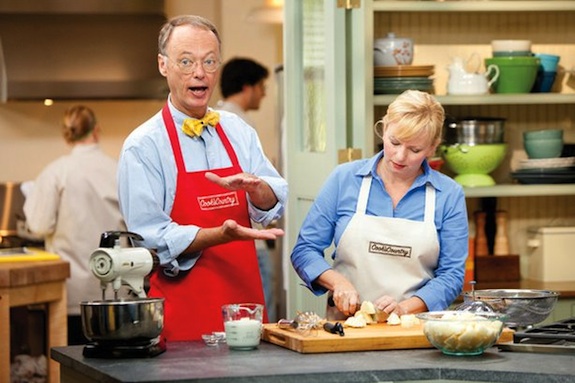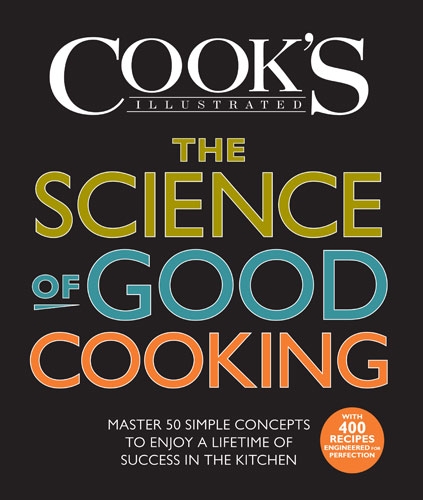The Science of Good Cooking: Tips From America’s Test Kitchen
The newest book from Christopher Kimball and company pairs good food with good science
![]()

Christopher Kimball on the set of America’s Test Kitchen with Bridget Lancaster. Photo by Daniel J. Van Ackere
In 1983, Christopher Kimball, founder of Cook’s Magazine, received a letter from an irate grandmother unhappy with his presentation of recipes and cooking. “You don’t cook from your heart,” she wrote. Kimball responded in the affirmative. “Yes,” he said, “I cook from my head.”
That approach helped Kimball, a slim man never without his bow tie and glasses, build an empire of inquisitive, science-based cooking with his magazine now named Cook’s Illustrated and PBS shows America’s Test Kitchen and Cook’s Country. Based out of a 2,500-square-foot kitchen outside of Boston, the magazine and television programs offer a tirelessly scrupulous approach to solving the kitchen’s persistent problems: Why does food taste better hot (science)? Does marinating really tenderize meat (no)? How do you get extra fluffy rice (rinse in water)? Kimball says, “The objective is to figure out why bad things happen to good recipes.” Accompanied by his even more fastidious science advisor, Guy Crosby–”working with Guy is like working with a Talmudic scholar”– Kimball tests dozens of different methods for each recipe, all so you don’t have to.
Which is fortunate, because as it turns out, “The science of cooking is actually much more complicated than particle physics or anything else that I’ve discovered,” according to Kimball.
In a world of stylized cooking shows with frequent exclamations of “Yum-o!” Kimball, 61, would appear out of synch. To him, cooking with your heart is as useless an expression as cooking with your pancreas. His delights are in trial and error, mastering the how and why. Stubbornly rigorous, Kimball is still far from a perfectionist. He says, “You never see Martha Stewart start a show saying, ‘This cakes looks terrible!’” But Kimball regularly includes failed recipes on his shows to show how common it is and how easy to overcome.

With scientific explanations of 50 cooking phenomena plus recipes, The Science of Good Cooking prepares the home chef for any challenge
In the recently released book, The Science of Good Cooking, Kimball and company (he works with a staff of more than three dozen) guide the reader through 50 concepts of cooking and more than 400 tested recipes. Perhaps a little more ambitious than physicist Richard Feynman’s Six Easy Pieces, the 50 concepts touch on everything from temperature to tools as a way to enhance not just the recipes in the book, but any dish you attempt in the kitchen.
Some of the tips offered and mysteries explained:
Don’t marinate meat, brine it: Counterintuitive but scientifically proven; salt makes meat juicy. According to the pros, “Salting poultry allows us to reap the benefits of brining as it breaks down proteins and helps to retain moisture within the meat.” The process even makes the skin crispier. Win-win. This is because, when the salt is first applied, through the process of osmosis, water is drawn out of the meat to the surface. But over time as the salt migrates inward, the expelled moisture returns as well, drawing water from the skin to plump the meat and dry the skin. Mouth watering yet? The same actually goes for dried beans, which should be brined instead of soaked. The pros recommend kosher salt but not all kosher salt is the same. “Because of its more open crystal structure, a teaspoon of Diamond Crystal actually contains less salt then a teaspoon of Morton kosher salt.” The book offers this handy conversion: 3 teaspoons of Diamond Crystal=2 1/4 teaspoons Morton.
Serve warm dishes at 98.5 degrees: Scientists, concerned with culinary satisfaction as they are, discovered tiny proteins in our taste buds that allow our sense of taste to be heightened with increased temperature (obviously to a degree, burning your tongue does not enhance flavor). The seemingly optimal temperature is somewhere around 98.5 degrees, depending on the food. Plus, “Much of our perception of flavor comes from aroma,” and, as the book points out, heated molecules are in an excited state more likely to reach our waiting noses. As a caveat, since some dishes are meant to be served cold (revenge not mentioned), the writers say you should flavor cold dishes more aggressively with seasoning.
Rest dough to cut down kneading time: “Kneading is the most enjoyable part of the breadmaking process,” the writers admit. But, they warn, over-kneading is a common sin that leaves the bread with less flavor and poor texture. You’ll know you’ve arrived at this sad place when your dough goes from a “wheaty tan” to a “grayish white.” The text explains that the point of kneading is to break down existing bonds and form stronger, straighter gluten sheets. But overknead, especially with electric mixers and you introduce both heat and air into your dough. The trick: autolyse, a technique first developed in the 1970s. Essentially all you have to do is rest your dough before kneading. The rest process actually takes care of some of the kneading work for you as enzymes go to work breaking down the mess of coiled protein to prepare for those nice gluten sheets later to come. According to the book, “Doughs that were given the 20-minute respite took an average of about five minutes less kneading.”
Fry foods between 325 and 375 using a mix of old and new oil: Nothing is worse than soggy fried chicken. Likewise, nothing is better than perfectly crisp fried chicken. The difference may be a matter of degrees. Most food is fried somewhere between 325 and 375 degrees (French fries, for example, are perfectly crisped at 325 degrees). It’s important to maintain this temperature (one of the reasons you fry in small amounts because dumping a large quantity of food into the pan lowers the overall temperature, warn the writers). Dropping a piece of battered shrimp into hot oil causes the surface moisture to escape in a burst of steam. That allows oil to move in. Too hot and too much moisture is lost meaning too much oil moves in, making the food greasy. But just right and the oil crisps the surface while allowing the meat to cook as well. And as a super secret way to make your food even crisper and more golden, the book recommends saving a cup of used oil to mix with fresh oil. Turns out, oil goes through five different stages while frying (beginning with “break-in” and “fresh” and ending with “degrading” and “runaway”) and right in the middle is the “optimum” oil. Mixing helps you avoid the first batch flop many of us have experienced.
Add milk to scrambled eggs, frozen butter to omelets: If you want scrambled eggs, most of us know to throw in a bit of milk or butter while scrambling. That’s because the lipids in the dairy coat the proteins in the egg (11 percent in the whites and 16 percent in the yolks) and slow down the process of coagulation, a.k.a. when the proteins are denatured and unfurl, releasing much of the water in the mixture. Adding fat helps keep some moisture in and fluff up the final product. But the same does not go for omelets. “While scrambled eggs should be fluffy, an omelet is more compact,” the authors write. While milk works for scrambled eggs, it can add to much moisture to an omelet. The chefs recommend frozen bits of butter instead, which melt more slowly and disperse more evenly. And it turns out you can go ahead and salt the eggs before you even cook them up. Because salt affects the electrical charge on the proteins, it weakens the bonds between them, preventing overcoagulation. Bring that up at your next brunch.
This is just a glimpse into the world of America’s Test Kitchen, where they don’t just find the right fry temperature, they find the individual smoke points of every oil (from coconut to peanut to canola). Precise and tested advice mixed with irresistible-sounding recipes for creamy parmesan polenta, crunchy baked pork chops and Boston cream cupcakes makes for a guide both the experienced home cook and the nervous beginner will enjoy.
“We’re not about gourmet food,” says Kimball. “We just want people to cook at home.”
Even Kimball admits, though, that are some kitchen conundrums he can’t solve. When asked if he’d found a way to really engage his own four kids with the science of cooking he said, “The only thing I’ve proved is they only want to cook with marshmallows and chocolate.”
/https://tf-cmsv2-smithsonianmag-media.s3.amazonaws.com/accounts/headshot/Leah-Binkovitz-240.jpg)
/https://tf-cmsv2-smithsonianmag-media.s3.amazonaws.com/accounts/headshot/Leah-Binkovitz-240.jpg)